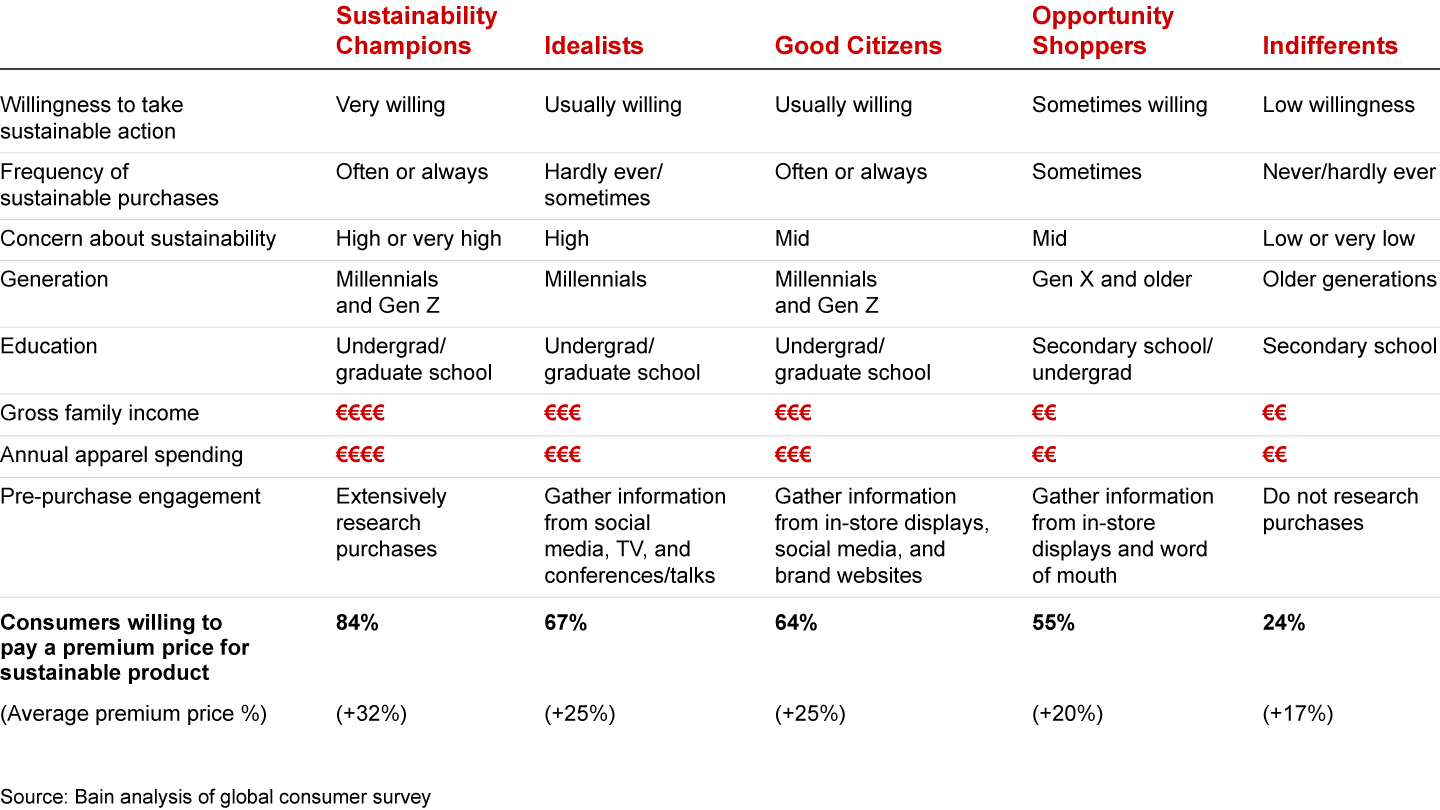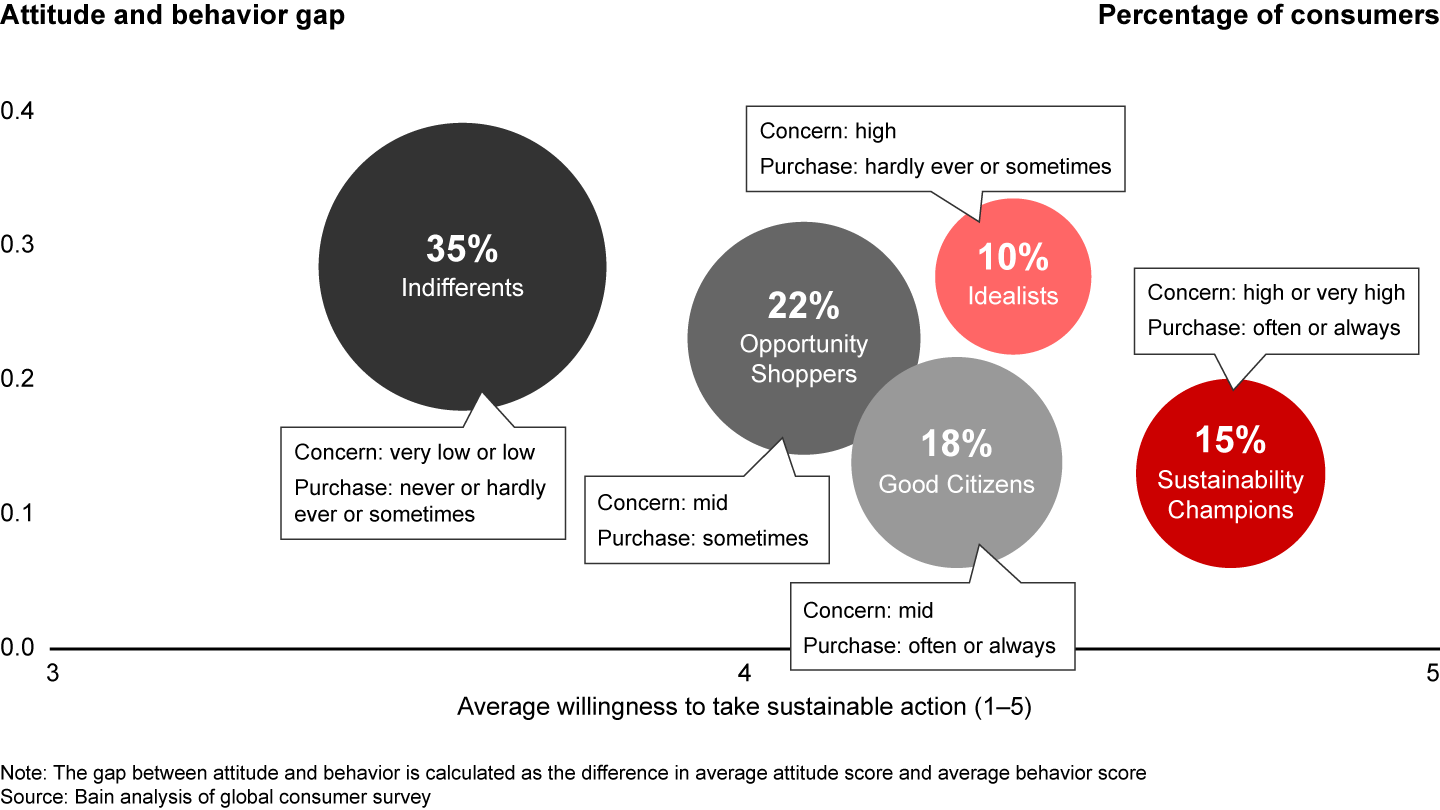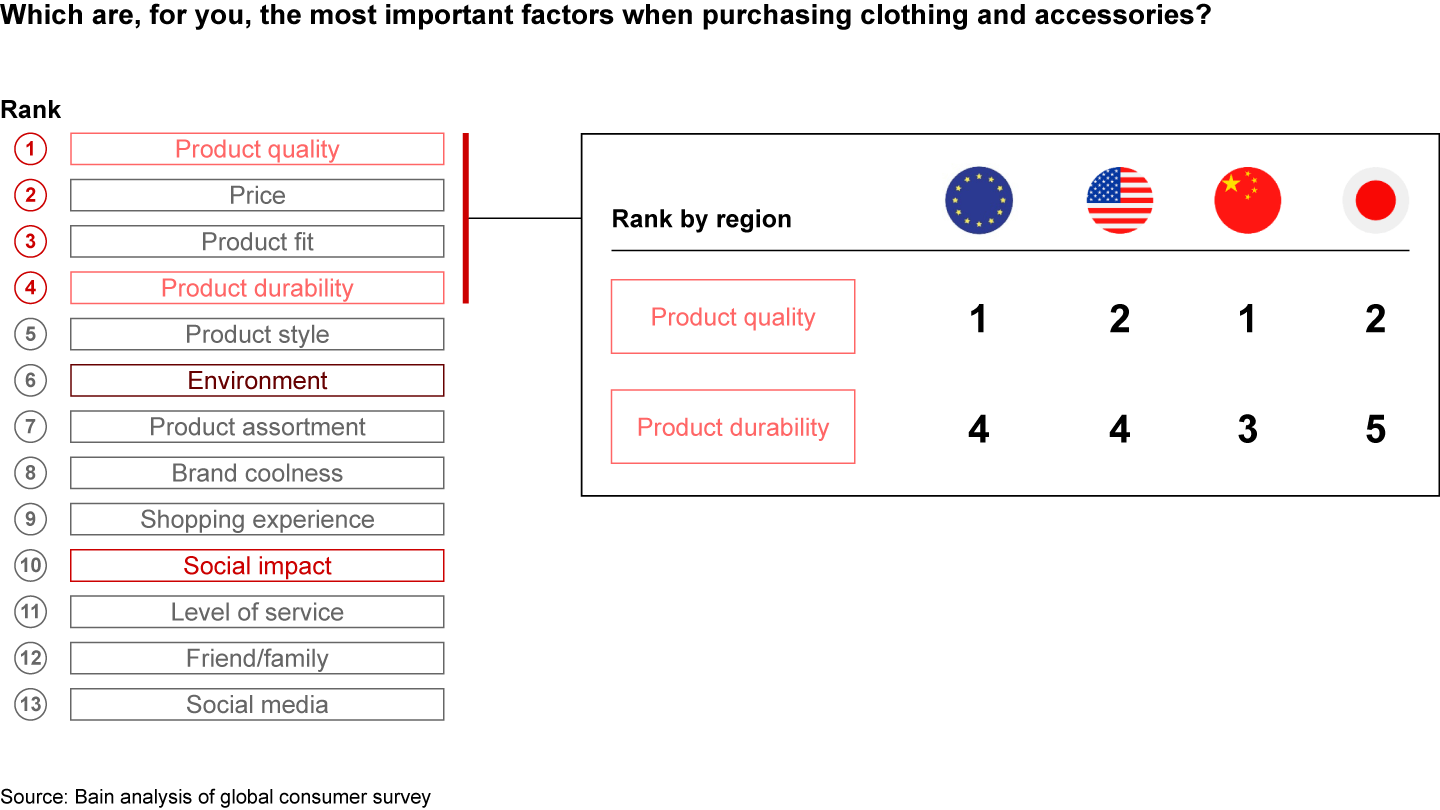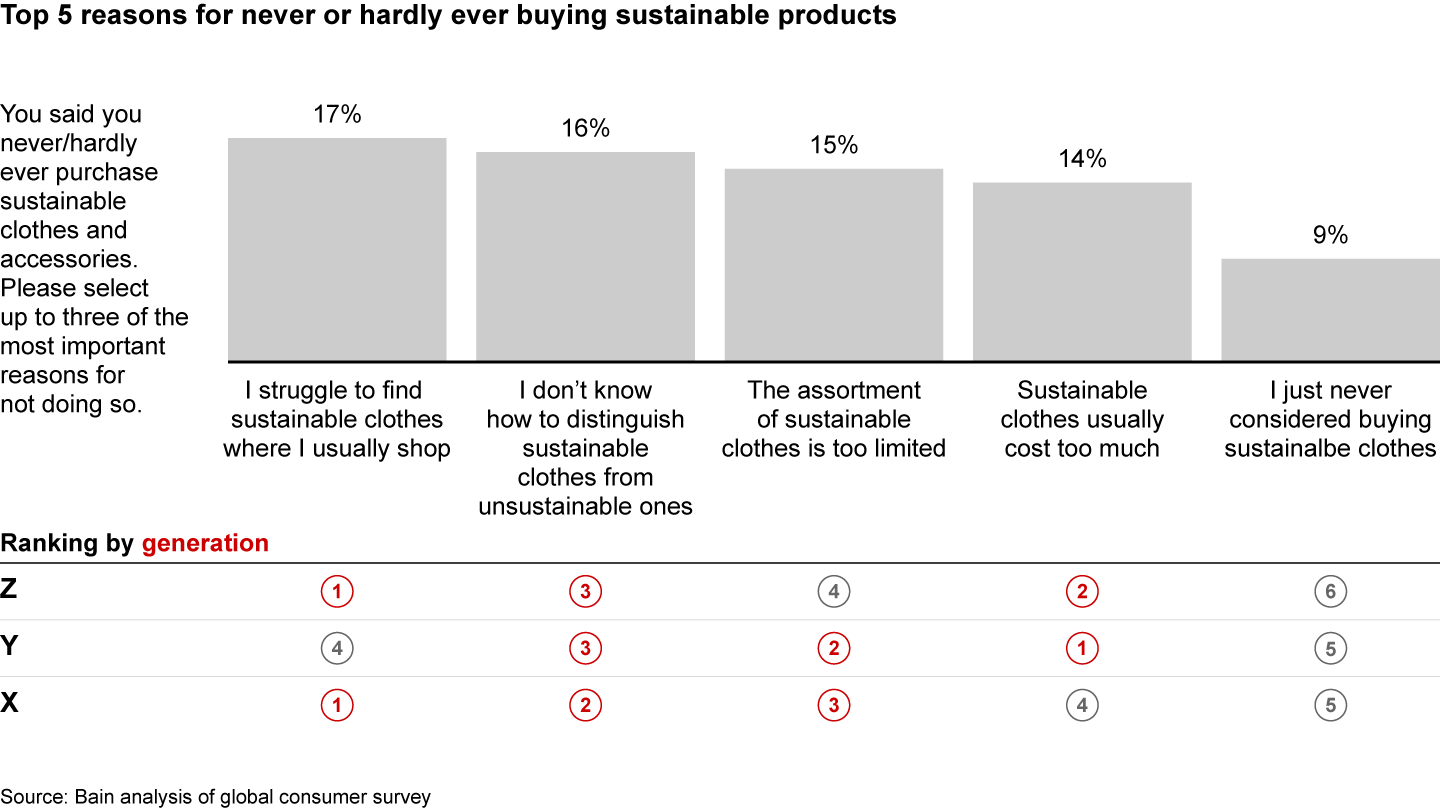Brief

At a Glance
- About 15% of global fashion consumers are already highly concerned about sustainability and consistently make purchasing decisions to lower their impact. That percentage could increase to more than 50% in the coming years as more shoppers gravitate toward sustainable practices.
- Our research identified five personas of global fashion consumers, ranging from those who care about sustainability to those who are indifferent to social and environmental issues when they shop, showing gaps between consumers’ attitudes and actual behaviors.
- By removing barriers and accelerating the inevitable shift toward sustainable shopping, fashion brands can capitalize on an expanding market opportunity and position themselves as leaders of an important cause.
- Three strategies will pave the way: Fashion brands must address the information gap; engage consumers on product durability and impact; and make sustainable purchases more convenient and appealing.
Clothing production doubled between 2000 and 2015, while the life span of garments shrank. Some clothes are discarded after only 7 to 10 wears, according to the Ellen MacArthur Foundation.
Unless the fashion industry makes a statement, the environmental impact of fashion is likely to increase. To curb emissions and achieve environmental, social, and governance (ESG) targets, fashion forward must take on new meaning—a meaning that intertwines durability, quality, impact and other external elements. In our last report we speculated that the very definitions of luxury and quality are likely to evolve, eventually including elements of impacts and externalities.
Written in collaboration with WWF Italy
Written in collaboration with WWF Italy

Five types of global fashion consumers
Manufacturing and disposal are only part of the fashion industry’s sustainability problem. After all, brands are responding to consumer demands.
So, what do consumers want? Do they care about sustainability in fashion?
Our research identified five personas of fashion consumers with well-defined socio-demographic profiles and behaviors (see Figure 1). The personas exist along a spectrum that measures consumers’ concern about sustainability, their willingness to take action, and their actual behavior. On one end, Sustainability Champions are highly concerned about the environment and regularly buy sustainable apparel. Their intentions and actions are aligned. On the opposite side, Indifferent consumers aren’t concerned about sustainability and seldom factor it into their purchasing decisions.

Along the continuum from Sustainability Champions to Indifferent consumers, concern for the environment and willingness to engage in sustainable behavior wanes (see Figure 2).

By understanding shoppers’ profiles, purchasing drivers, and obstacles, brands can deploy dedicated strategies to address unmet needs and shift consumers toward more sustainable consumption.
Fashion consumers care about sustainability but don’t have the information to act on it
Approximately 65% of fashion consumers care about the environment, but only some regularly prioritize sustainability in their shopping.
We measured consumers’ stated willingness to lower their impact across a wide set of sustainable actions and compared that to their actual behavior. Differences between what consumers say and what they do—the so-called attitude-behavior gap—emerged across the entire set of activities (see Figure 3). Consumers exhibited positive attitudes about sustainability (i.e., they expressed a high willingness to perform actions they believe are more sustainable) but frequently failed to execute on these attitudes by engaging in responsible behaviors regarding sustainability.

The attitude-behavior gap is particularly strong among certain consumer personas. For example, Idealist consumers are very concerned about sustainability but hardly ever purchase sustainable fashion.
The attitude-behavior gap is widest when sustainable action requires extra effort, such as collecting and verifying information. It’s much easier for consumers to discard a garment responsibly (through donation or reuse) than it is to check labels or investigate a brand.
Durability and quality are tied to sustainability—even if customers don’t recognize it
Despite being among the top six purchase drivers for global fashion customers, sustainability is an explicitly lower priority than other, more tangible factors. Social impact—which encompasses elements such as fair labor conditions; diversity, equity, and inclusion (DEI); and impact on communities—ranked 10th. The low ranking indicates these are secondary purchasing factors for most consumers, not primary motivators.
Product quality is the leading purchasing factor for fashion consumers, ahead of price, product fit, and style (see Figure 4). Quality is a top purchasing factor in all the countries that were surveyed, which means it has consistent, global appeal. Durability ranks fourth among the top purchasing factors and is also consistent across countries.

Here’s the good news: Durability and quality are closely related to sustainability. They directly impact (and extend) a product’s lifetime. And they are actionable.
The attitude-behavior gap is smaller for tasks like “buying higher-quality clothes” than it is for many other sustainable actions. That’s because consumers understand (and value) quality and durability. They can see, feel, and experience it. In comparison, “sustainability” seems abstract, vague, or even subjective. There are multiple ways to measure sustainability but no simple ways to distinguish it.
Higher-quality, durable items have more resale and reuse opportunities—for brands and consumers. Resale can increase a company’s profit margin per product, introduce new revenue streams, and broaden its range of potential consumers. (In this prediction piece, we estimate that resale could account for 20% of a luxury company’s revenue by 2030.) “Pre-loved” merchandise can become part of a brand narrative around enduring quality and value.
Also, most consumers say they are willing to pay more for higher-quality clothes, especially if sustainability is connected to the price tag. Sixty-four percent of Good citizen consumers said they’d pay more for sustainable clothes, whereas only 24% of Indifferent consumers would pay a premium for sustainable fashion at all.
Willingness to pay more increases with consumers’ concern for sustainability, and so does the average premium price consumers are willing to accept. Most Sustainability Champions (84%) are willing to pay more for sustainable products, but less than a third would pay more for premium fashions in general.
Limited availability of sustainable options is a major obstacle
Consumers who want to purchase sustainably often find it challenging (see Figure 5). Why?

Consumers who never or hardly ever buy sustainable clothing said it’s hard to find sustainable options where they usually shop, sustainable assortments are limited, and it’s difficult to distinguish between sustainable and nonsustainable items.
These barriers were consistent among every generation of fashion consumer. Younger consumers said higher prices are a deterrent, too.
Assortment isn’t the only issue. A third of consumers said they can’t distinguish sustainable products or brands from those that aren’t. That challenge increases with age. One out of three Baby Boomer and Silent Generation respondents said they don’t know where to find sustainability information for brands or products. By comparison, only one out of five Gen Z and Gen Y/Millennial respondents reported the same difficulty.
Fashion brands are on the cusp of a great opportunity but are often overwhelmed by complexity, especially along lengthy supply chains. They’re waiting for consumers to signal stronger interest in sustainability. Meanwhile, consumers are unable to articulate what they want. They care about sustainability but lack a common definition or standard to demand.
But there is momentum. Concern for sustainability is strong among younger generations—and growing overall. Brands that demonstrate leadership and execute on sustainability can secure a competitive advantage and win a large share of a rapidly growing market.
How to accelerate sustainable fashion shopping
Three strategic actions will help fashion brands overcome purchasing barriers, close the attitude-behavior gap, and accelerate sustainable shopping. Brands must address the information gap; engage consumers on product durability and impact; and make sustainable purchases more convenient and appealing.
1. Increase transparency to reduce the information gap
It takes too much effort for consumers to determine whether clothes are sustainable.
Most consumers underestimate the fashion industry’s role as a pollutant, so it doesn’t factor into their shopping decisions. Nor do they fully know the social impacts associated with garment production. Other consumers recognize and care about sustainability in fashion but are bogged down by the complexity. Global supply chains and production processes make it difficult to evaluate the social and environmental impacts of a single garment.
Closing the information gap would decrease the attitude-behavior gap in fashion consumption. Good Citizens are motivated to “do the right thing” if it’s presented to them. Idealists care about sustainability but don’t know how to act on it. Those personas (28% of the market) need more information, not motivation, to purchase sustainably.
To overcome this barrier, in-store displays, labels, and product descriptions need to be clear, easily available, and reliable. Best-in-class brands already include supply chain and partner information, material descriptions, and stories about the communities involved in the making of their clothing. Shedding light on their production processes engages consumers in a genuine and transparent way. Product packaging is another means to communicate (and practice) sustainability.
Brands can also leverage consumers who are already Sustainability Champions. Champions are more than just “target customers”; they are trusted friends and family who can drive sustainable purchasing. Most persona groups rely on social media and word of mouth to research purchases, so brands can benefit from making sustainability information easy for Champions to share.

How Brands Can Embrace Sustainable Fashion
Experts from Bain and WWF on ways to reduce fashion’s environmental impact.
2. Engage consumers on product durability and impact-per-wear information
Fashion consumers want durability. Above everything else, they want high-quality products and they expect them to last. Even Indifferent consumers, who show little consideration toward sustainability when they shop for clothes, are driven by product durability and quality.
Durability and quality appeal to a wide swath of consumers across generations and income levels and are more relevant to consumers than some intangible features. They don’t require any less effort on consumers’ behalf, and consumers already value them.
Brands can capitalize on these aspects of sustainable fashion and appeal to value-seeking shoppers—as long as they achieve durability without compromising any social or environmental factors. By positioning durability as an element of sustainable fashion, brands offer consumers a win-win situation: Consumers can engage in sustainable activities without weakening key purchasing factors.
Strategically, brands can present durability, quality, and sustainability in the same thread. If brands position fashion as an investment rather than a short-term or seasonal purchase, quality can become a gateway to more sustainable shopping, even among the least-concerned consumers. Brands can engage consumers on durability by including information, such as impact-per-wear or the expected life span of a garment, on product tags or labels.
When impact is presented alongside cost, it’s easier for consumers to make sustainable selections. A garment that lasts a lifetime delivers more value and a lower environmental impact than a lesser-quality choice. Additionally, brands can teach consumers how to repair worn goods, mend garments for them, or resell previously loved items. Reuse initiatives encourage sustainable behavior across a longer product life cycle.
By focusing on durability and quality, brands can shift the industry away from business models that rely on overconsumption and continued volume growth. Brands can grow by extracting more value per product sold, ultimately decoupling growth from volume. High-quality and durable items can command higher revenues per item, and brands can continue to extract value throughout the product’s lifetime through resell and rental models. Resale strategies can also diversify and expand the market for some fashion brands.
3. Make sustainable shopping more convenient and appealing
Many shoppers follow the path of least resistance; their shopping habits are driven by convenience rather than social impact or public opinion. But with simpler and more convenient options, they would increase their sustainable purchasing.
Consumers said sustainable products aren’t available in stores where they shop or the assortment is too limited. They also struggle to distinguish sustainable products and brands from non-sustainable ones. So, even if a shopper wants to purchase sustainably, the product they want might be hard to find.
Unmet demand is readily available for brands and retailers that strengthen their sustainable assortment and make sustainable purchasing easier for consumers.
To achieve this, brands can use store zoning and dedicate space for sustainable products and displays. They can also invest in salesforce training to help consumers find, understand, and purchase more sustainable products.
Activities that increase transparency also increase appeal. For example, storytelling about a garment’s origins or source materials helps consumers distinguish a product as sustainable and creates positive associations with the purchase.
Make sustainability your statement piece
Sustainable shopping is an inevitable sea change. Don’t wait for it. Accelerate it.
Brands that proactively design sustainability into their strategy and operations will cement their relevance and capture a windfall of unmet demand, now and into the future. Most consumers want to purchase more sustainably; they just need help doing so.
Fashion brands can make sustainable purchasing easier for all consumers, not just Sustainability Champions. If brands embrace the sustainability conversation, everyone will benefit.
To start, engage consumers on qualities they care about—durability, quality, value—and help them see these elements through a sustainability lens. Invest in transparency and convenience strategies to shrink the attitude-behavior gap.
Younger consumers demand greater corporate responsibility. They can increasingly discern actual impact from greenwashed marketing ploys, and they want to wear their values on their sleeves. Leaders in the fashion industry will meet their demands.
It’s not an impossible shift. With commitment from the fashion industry, every consumer can be guided toward more sustainable choices and a more promising future.

About WWF
World Wide Fund for Nature (WWF) is one of the world’s largest and most experienced independent conservation organizations, with more than 5 million supporters and a global network active in more than 100 countries. WWF’s mission is to stop the degradation of the planet’s natural environment and to build a future in which humans live in harmony with nature, by conserving the world’s biological diversity, ensuring that the use of renewable natural resources is sustainable, and promoting the reduction of pollution and wasteful consumption.

About the Research
Data powered by Dynata, a leading global first-party data and insights platform.




